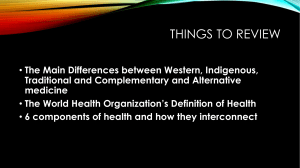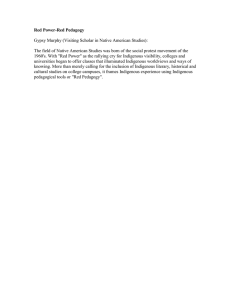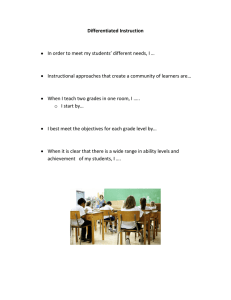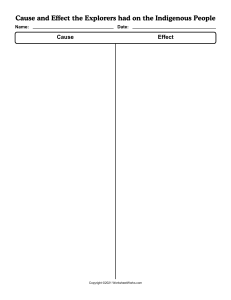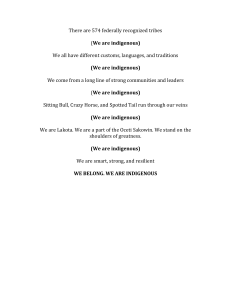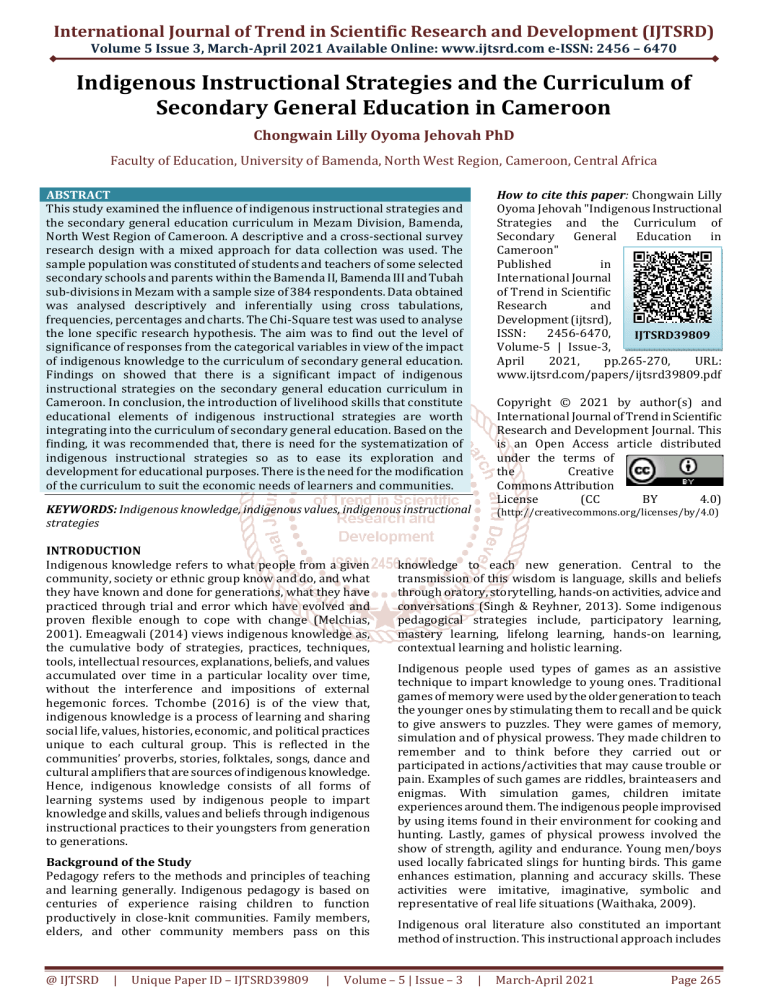
International Journal of Trend in Scientific Research and Development (IJTSRD)
Volume 5 Issue 3, March-April 2021 Available Online: www.ijtsrd.com e-ISSN: 2456 – 6470
Indigenous Instructional Strategies and the Curriculum of
Secondary General Education in Cameroon
Chongwain Lilly Oyoma Jehovah PhD
Faculty of Education, University of Bamenda, North West Region, Cameroon, Central Africa
ABSTRACT
This study examined the influence of indigenous instructional strategies and
the secondary general education curriculum in Mezam Division, Bamenda,
North West Region of Cameroon. A descriptive and a cross-sectional survey
research design with a mixed approach for data collection was used. The
sample population was constituted of students and teachers of some selected
secondary schools and parents within the Bamenda II, Bamenda III and Tubah
sub-divisions in Mezam with a sample size of 384 respondents. Data obtained
was analysed descriptively and inferentially using cross tabulations,
frequencies, percentages and charts. The Chi-Square test was used to analyse
the lone specific research hypothesis. The aim was to find out the level of
significance of responses from the categorical variables in view of the impact
of indigenous knowledge to the curriculum of secondary general education.
Findings on showed that there is a significant impact of indigenous
instructional strategies on the secondary general education curriculum in
Cameroon. In conclusion, the introduction of livelihood skills that constitute
educational elements of indigenous instructional strategies are worth
integrating into the curriculum of secondary general education. Based on the
finding, it was recommended that, there is need for the systematization of
indigenous instructional strategies so as to ease its exploration and
development for educational purposes. There is the need for the modification
of the curriculum to suit the economic needs of learners and communities.
How to cite this paper: Chongwain Lilly
Oyoma Jehovah "Indigenous Instructional
Strategies and the Curriculum of
Secondary General
Education in
Cameroon"
Published
in
International Journal
of Trend in Scientific
Research
and
Development (ijtsrd),
ISSN:
2456-6470,
IJTSRD39809
Volume-5 | Issue-3,
April
2021,
pp.265-270,
URL:
www.ijtsrd.com/papers/ijtsrd39809.pdf
KEYWORDS: Indigenous knowledge, indigenous values, indigenous instructional
strategies
(http://creativecommons.org/licenses/by/4.0)
INTRODUCTION
Indigenous knowledge refers to what people from a given
community, society or ethnic group know and do, and what
they have known and done for generations, what they have
practiced through trial and error which have evolved and
proven flexible enough to cope with change (Melchias,
2001). Emeagwali (2014) views indigenous knowledge as,
the cumulative body of strategies, practices, techniques,
tools, intellectual resources, explanations, beliefs, and values
accumulated over time in a particular locality over time,
without the interference and impositions of external
hegemonic forces. Tchombe (2016) is of the view that,
indigenous knowledge is a process of learning and sharing
social life, values, histories, economic, and political practices
unique to each cultural group. This is reflected in the
communities’ proverbs, stories, folktales, songs, dance and
cultural amplifiers that are sources of indigenous knowledge.
Hence, indigenous knowledge consists of all forms of
learning systems used by indigenous people to impart
knowledge and skills, values and beliefs through indigenous
instructional practices to their youngsters from generation
to generations.
Background of the Study
Pedagogy refers to the methods and principles of teaching
and learning generally. Indigenous pedagogy is based on
centuries of experience raising children to function
productively in close-knit communities. Family members,
elders, and other community members pass on this
@ IJTSRD
|
Unique Paper ID – IJTSRD39809
|
Copyright © 2021 by author(s) and
International Journal of Trend in Scientific
Research and Development Journal. This
is an Open Access article distributed
under the terms of
the
Creative
Commons Attribution
License
(CC
BY
4.0)
knowledge to each new generation. Central to the
transmission of this wisdom is language, skills and beliefs
through oratory, storytelling, hands-on activities, advice and
conversations (Singh & Reyhner, 2013). Some indigenous
pedagogical strategies include, participatory learning,
mastery learning, lifelong learning, hands-on learning,
contextual learning and holistic learning.
Indigenous people used types of games as an assistive
technique to impart knowledge to young ones. Traditional
games of memory were used by the older generation to teach
the younger ones by stimulating them to recall and be quick
to give answers to puzzles. They were games of memory,
simulation and of physical prowess. They made children to
remember and to think before they carried out or
participated in actions/activities that may cause trouble or
pain. Examples of such games are riddles, brainteasers and
enigmas. With simulation games, children imitate
experiences around them. The indigenous people improvised
by using items found in their environment for cooking and
hunting. Lastly, games of physical prowess involved the
show of strength, agility and endurance. Young men/boys
used locally fabricated slings for hunting birds. This game
enhances estimation, planning and accuracy skills. These
activities were imitative, imaginative, symbolic and
representative of real life situations (Waithaka, 2009).
Indigenous oral literature also constituted an important
method of instruction. This instructional approach includes
Volume – 5 | Issue – 3
|
March-April 2021
Page 265
International Journal of Trend in Scientific Research and Development (IJTSRD) @ www.ijtsrd.com eISSN: 2456-6470
the use of story-telling such as myths, fables, moral tales,
legends and allegories and thought provoking banters such
as proverbs, riddles, aphorisms and parables. Indigenes
learnt about their origin, history, culture and religion, from
oral tradition. It was a reservoir of inexhaustible knowledge
about the meaning and reality of life, morals, norms and
survival techniques (Omolewa, 2007a). Story-telling was
also used as an important pedagogical tool and a primary
form of indigenous oral tradition. It was used to transmit the
culture, experience, values, knowledge and wisdom from one
generation to the other (Fasokun 2005). Stories telling was
an act of entertainment but more importantly, it was used to
express feelings, and to teach ideal forms of behaviour and
morality. story-telling is to induct the youth into the moral,
philosophical, and cultural values of the community. Boys,
girls and even babies listened to their parents and imitated
the heroes in the stories. This knowledge transfer approach
of cultural values indicates that, learners make meaning out
of what they hear (Ross, 2006).
Proverbs were used by indigenous people as a pedagogical
hook with the role of provoking critical thinking. These
thought-provoking statements and observations about life
portray the entire worldview of indigenous people. They are
perceived as catalysts of knowledge, wisdom, philosophy,
ethics and morals. They call for a deeper reflection and
further thinking and consideration of issues. Thus because of
the beclouded nature of African proverbs, learners think
beyond bounds, they wonder and think critically to enhance
their creativity and capacity to make open-minded
interpretations (Ngalim & Stanislaus, 2020). Proverbs
enshrine wisdom, beliefs and the accumulated experiences
of past and present generations. In most African traditional
cultures, the use of proverbs is a common feature in the
transmission of educational values (Omolewa, 2007a).
Another teaching technique that was used in African
societies to teach issues, concepts, entertainment and as a
medium of passing information is music and dance
(Nsamenang & Tchombe, 2011). Learners looked forward to
the music and dance sessions with excitement because
creativity and choice are usually encouraged and nurtured
(Omolewa, 2007a). Language acquisition, speech therapy,
literacy, numeracy, and other related themes were learnt
through music and dance. They helped to equip the learners
with the ability to function effectively in other areas of life.
Lastly, verbal warnings were used and more often followed
by punishment. Children who committed offences might be
rebuked, smacked or assigned some piece of work to
complete. Serious offences and disciplinary problems,
however, resulted in severe beating or other forms of
inflicting pain on the body. Such punishment was regarded
as reformatory (Kenyatta, 1938 cited in Teresa and Mba,
2013).
Principles of indigenous education
African indigenous education is founded on sound principles
given that, it embodies educational elements such as
objectives, content and instructional strategies. The main
objective of indigenous education in Africa is to equip the
learners with knowledge, skills and attitudes that will make
them to live a holistic life, which upholds the cultural values
and is responsive to the family and community needs
(Omolewa, 2007b).
Ocitti (1973) as cited by Adeyemi & Adeyinka (2002)
identified five principles through which African indigenous
@ IJTSRD
|
Unique Paper ID – IJTSRD39809
|
education equips the younger generation with knowledge
skills and attitudes. which are; preparationism,
functionalism, communalism, perennialism and holisticism.
The principle of preparationism asserts that, education
prepares its recipients to adjust to the community and to
play a useful role in it. Children developed a sense of
obligation towards the community and grew to appreciate
its history, language, customs and values. This is perhaps one
of the greatest attributes of indigenous education (Kelly,
1991 cited in Adeyemi & Adeyinka, 2002). According to
Osaat & Asomeji, (2017), the role of teaching and learning is
to equip boys and girls with the skills appropriate to their
gender in preparation for their different roles in the society.
For example, in most African traditional societies most girls
were taught on domestic chores and farming so as to become
good wives and mothers. While boys were prepared to
become hunters and warriors, farmers, craftsmen and other
male dominated occupations so as to become good
husbands, fathers and family or community leaders.
The second principle of functionalism holds that, the
purpose of education is to make learners productive so that
they can be useful and integrated into their communities.
The gap which today exists between study and the world of
work was absent in pre-colonial society. Indeed, there was
no unemployment in African traditional societies. Learners
are to be empowered to become fully integrated into the
occupation even before they graduate. Education therefore is
always practical, and within a practical concrete context
(Adeyemi & Adeyinka, 2002).
According to the third principle of communalism, children
belonged to the community and every member of the
community participates in their upbringing (Adeyemi &
Adeyinka, 2002). Parents sought to bring up their children
within a community in which each person sees his wellbeing in the welfare of the group. Children were brought up
largely by the process of socialism as opposed to the process
of individualism. This was done to strengthen the organic
unity of the clan. In the absence of any immediate parent,
any other member of the community can teach or correct a
child. This makes teaching a collective responsibility (Njoki,
2013).
Perennialism is the fourth principle. It perceives education
as a vehicle for maintaining or preserving the cultural
heritage and status quo. The African indigenous education is
conservative and is aimed at maintaining cultural heritage
that has been handed down from one generation to the
other. Generally, perennialism as a principle believes that, it
is more beneficial to stick to certain absolute principles in a
world that is so uncertain. It, therefore, sees education as a
way of preparing the child to become acquainted with the
finest achievements of his cultural heritage, to become aware
of the values of his heritage (Adeyemi & Adeyinka, 2002).
Lastly, this principle of holisticism sees African indigenous
education as an enabler for young people to acquire a variety
of skills that made them productive in many ways. The
learners are involved in a variety of occupations and could
acquire skills and knowledge in different domains of
activities. A boy could work as a builder, farmer and
fisherman. A woman worked as a gardener, housewife and
cook, besides being a caretaker and nurse to her children
(Adeyemi and Adeyinka, 2002). Thus, indigenous education
is a multiple kind of education.
Volume – 5 | Issue – 3
|
March-April 2021
Page 266
International Journal of Trend in Scientific Research and Development (IJTSRD) @ www.ijtsrd.com eISSN: 2456-6470
Hands-on learning curriculum perspectives and
indigenous instructional strategies
Hands-on learning curriculum consists of learning by doing.
It involves enabling the child’s ability to think critically in a
total learning experience by involving profundity of
investigation using ideas, objects and materials as well as
drawing the depth of investigations with objects, materials
and phenomena. It entails using ideas and implicating the
meaning and understanding from the experiences that
students perform (Haury & Rillero, 1994, cited in Özlem &
Jale, 2011). African indigenous pedagogies employ
participatory processes at home and in the community, to
promote learning through religious activities, and peer/age
group activities, as “hands-on” and “work–play” activities,
without a teacher who explains the procedures to follow in
details (Pence & Nsamenang, 2008).
Hands-on curriculum deals mainly with any instructional
approach involving activity and direct experience with
natural phenomena or any educational experience that
actively involve learners in manipulating objects to gain
knowledge or understanding. According to Özlem and Jale
(2011), hands-on learning is a good idea to engage students
actively in their learning. Hands-on activities are inexpensive
by using easily obtainable and simple life materials, straight
forward and practical to perform in class and adaptable for
most of the lessons. It caters to all learning styles consisting
of kinaesthetic, visual, adaptive and audio visual learners.
The elements that constitute hands-on curriculum
perspective are: The orientation of educational objectives
should be geared towards the development of skills to
enable learners to be self-reliant and be less dependent on
external factors. This corroborate with the one of the
educational characteristic and function of indigenous
knowledge. The content of education here is supposed to be
based on the establishment of the relation between
knowledge and it practical application in each domain of
study and instructional activities here are supposed to be
oriented on the development of the learner’s skills. Hence,
instructional activities such as tutoring, coaching, mentoring
and learners’ participation among other should prime
(Özlem & Jale, 2011).
Hands-on learning curriculum from the preparationism and
functional perspectives of indigenous education express the
need for education to equip learners with particular skills
and knowledge that can enable them fulfil their role and
responsibility toward family and society.
In all, the relevance of curriculum perspectives to indigenous
education lies in the fact that, their educational and
instructional orientation corroborate with objectives and
characteristics of indigenous knowledge. The need to relate
knowledge with skills make learning practical as with the
case of hands-on curriculum perspective, and the need to
make education functional to serve the society or community
it is meant for is substantiated in community-centred
curriculum perspective. From a holistic view, the educational
features of indigenous knowledge fit with the competence
curriculum models.
Theoretical Review
Cognitive Apprenticeship Learning Theory and
Indigenous
Instructional
Strategies:
Cognitive
apprenticeship is a theoretical instructional model that
describes the design of a learning environment and helps
novices become experts through guided learning. Teaching
@ IJTSRD
|
Unique Paper ID – IJTSRD39809
|
strategies align well with goals and objectives to be taught in
order to produce discipline-specific expertise. (Austin,
2009). In this model, the teacher is expected to explain
systematically or procedurally, the cognitive processes, the
learners are to observe, practice, and produce. These tasks
are usually highly cognitive and complex in nature hence
results in the acquisition of cognitive and meta-cognitive
skills. They observe expert performance to facilitate skill
development, and are able to carry out the same process on
their own and also achieve the same objective as the expert.
(Stalmeijer et. al., 2013). Cognitive Apprenticeship allows
learners to actively practice what they have learned in a reallife environment.
Instructional strategies associated with cognitive
apprenticeship
Collins, Brown, and Newman (1989) as cited in Giebler et. al.
(2019) associate six general instructional strategies with
cognitive apprenticeship. They are designed to help learners
acquire cognitive and meta cognitive skills through
processes of observation, guided and supported practice
which enables them to develop individual problem-solving
strategies. The teaching strategies include modelling,
coaching, scaffolding articulation, reflection and exploration.
Modelling: It involves the teacher actively demonstrating,
explaining skills and procedures to learners. They observe
the teacher perform activity and are expected to
demonstrate both the physical act and his thinking. The
teacher articulates an approach to problem solving
(heuristics) and intentional thought process (controlled
processes). Learners observe the teacher performing a task
and ask questions (Walker et. al., 2017).
Coaching: The teacher observes the learners while providing
specific feedback on their performance. This enables the
performance of the learners to be similar to the performance
of the expert (Walker et. al., 2017). Coaching is realized
through interactions that are “immediately related to
specific events or problems that arise as the student
attempts to carry out the target task” (Collins, Brown, &
Newman, 1989 as cited by Giebler et. al., 2019).
Scaffolding: This involves the teacher offering support in the
form of suggestions or material when he recognizes that a
student is not able to solve a certain aspect of a task, the
students and the teacher solve problems in a cooperative
way (Giebler et. al., 2019). The teacher provides the
necessary support the student needs while learning
something new and gradually reduces the support as the
learner becomes more independent. This makes the learner
to stand a better chance of using that knowledge
independently.
Articulation: This occurs when students are given the
opportunity to articulate their understanding of a particular
task, concept, or method through some type of content
mastery assessment (Stalmeijer et al., 2010). The teacher
encourages students to ask questions and explain their
thought processes and understanding. This helps to deepens
knowledge, understanding, and memory in learners (Walker
et. al., 2017).
Reflection: This involves teacher asking the learner question
in order to find out what they know. The teacher is expected
to asks for learners’ views to know what they have
understood. Depending on the responses, the teacher may
explain what they have not understood. (Walker et. al.,
Volume – 5 | Issue – 3
|
March-April 2021
Page 267
International Journal of Trend in Scientific Research and Development (IJTSRD) @ www.ijtsrd.com eISSN: 2456-6470
2017). Reflection occurs when students ponder over on their
own problem-solving strategies and understanding of
concepts and compare them to other experts and/or
students. Students look back over their efforts to complete a
task and analyse their own performance.
Exploration: In this stage the learner is able to accomplish
tasks and solve problems independently. The teacher offers a
task/problem the students have to solve on their own
(Giebler et. al., 2019). The learners try out different
strategies, hypotheses and observe their effects in order to
set and pursue personal learning goals. Learning is selfdirected and guided by learners which enables them to be
engaged and focused on the learning process. This equally
helps teachers to find learning experiences that are
meaningful for learners.
Statement of the Problem
Western philosophies of education have been the source of
knowledge base in formal schooling in most societies across
the world while indigenous philosophies had little or no
impact. This is based on the assumption that indigenous
knowledge and philosophies is unempirical, superstitious,
primitive and traditional (Breidlid, 2013). The same
indigenous instructional strategies had relevant and
appropriate content for the education of children before
colonial education. This is coupled with the fact that, despite
the remarkable educational orientation law that recognizes
and recommends the inclusion of cultural values in the
country’s educational systems, its effect is not yet visible.
More so, unlike learners of secondary technical education,
most learners of secondary general education upon
completion of their educational circle lack adequate skills
that can enable them to be self-reliant. Thus, the major
reflection at the centre of this study is to assess the impact of
indigenous instructional strategies in the secondary school
curriculum of general education
Objectives of the Study
This study is guided by a lone objective;
To find out the impact of indigenous instructional strategies
on the curriculum of secondary general education.
Research questions
What is the impact of indigenous instructional strategies on
the curriculum of secondary general education?
Research hypothesis
Ho: There is no significance impact of indigenous
instructional strategies on the curriculum of secondary
general education.
Ha: There is significance impact of indigenous instructional
strategies on the curriculum of secondary general education.
Research Methodology
A descriptive survey research design was used in this study.
The Sample size was 384.A questionnaire and open-ended
questions were used for data collection.
Data Analysis
Quantitative data was analysed using descriptive statistical
analysis, while Chi-square test of independence was applied
as inferential analysis to test the research hypothesis using
the formula;
Chi-square (X2)=
. Where, ∑=Summation and
O=Observed frequency
The level of significance used in test statistics (p) = 0.05 or
5%. This implies that the result obtained will be (100-5) %
or 95% reliable.
Verification of Hypothesis
Ho: There is no significant impact of indigenous instructional strategies on secondary general education curriculum in
Cameroon.
Ha: There is no significant impact of indigenous instructional strategies on secondary general education curriculum in
Cameroon.
Yes
No
Total for observed
Table 1: Chi-Square Test Statistic
Students
Teachers
Parents
Observed
96
78
48
Expected
111
78
34
Observed
84
48
6
Expected
69
49
21
180 (50%) 126 (35%) 54 (15%)
Total
222
138
360 (100%)
Chi-square (X2)=
X2 = (96-111)2+ (78-78)2 + (48-34)2 + (84-69)2+ (48-49)2+ (6-21)2
111
78
34
69
49
21
= 2.03 + 5.8 + 3.3 + 0.02 + 10.7
= 21.9
Conclusion:
Given that the test statistics (21.9) is greater than the critical value (5.99), the null hypothesis was rejected and the alternative
hypothesis which states that, there is a significant impact of indigenous knowledge systems on secondary general education
curriculum in Cameroon was accepted. The responses gotten from the interviews show that, integrating indigenous knowledge
and practices into school curriculum will make learning contextual, livelihood skills and knowledge and moral values will also
be transmitted to learner as shown on the table below.
@ IJTSRD
|
Unique Paper ID – IJTSRD39809
|
Volume – 5 | Issue – 3
|
March-April 2021
Page 268
International Journal of Trend in Scientific Research and Development (IJTSRD) @ www.ijtsrd.com eISSN: 2456-6470
Table 2 Frequencies on the Benefits of Integrating Indigenous Knowledge and Practices in School Curriculum
Themes
Frequency Percent Cumulative Percent
Learning will be contextual
8
33.0
33.0
Children will have skills and knowledge to transform communities
11
46.0
79.0
Communities will benefit in terms of morality
5
21.0
100.0
Total
24
100.0
Figure 1: Distribution of grouped themes in open ended question
Summary of findings
This questions examined here is the impact of indigenous
instructional strategies on the curriculum of secondary
general education. Statistically, the findings show that,
indigenous instructional strategies have a significant
relevance to the curriculum of secondary general education.
Most of the respondents were of the view that indigenous
instructional strategies such as oral instructional activities,
hands on activities and contextual learning build
competence and skills in learners and as such, are worth
being incorporated into the curriculum of secondary general
education. This will help improve teaching and learning in
schools. Ngalim and Stanislaus (2020) is in agreement with
this perception on the use of traditional oral instructional
strategies which provide pedagogic techniques that provoke
critical thinking skills in learners.
Conclusion
African indigenous instructional strategies according to Korb
(2018) is holistic and develops all aspects of an individual,
including the cognitive, physical, social, and spiritual
domains. There is the need to include hands-on activities and
traditional oral instructional activities to make the content of
the secondary general curriculum contextual. It is also in
agreement with the cognitive apprenticeship theory that
gives priority to hands-on pedagogical activities which is a
clear demonstration of the implication of indigenous
pedagogical practices to the curriculum.
Recommendations
It was recommended that the curriculum of secondary
general education be reformed by introducing livelihood
skills. There is the need for the systematization of indigenous
instructional strategies so as to ease the exploration and
development for educational purposes. There is also the
need for the modification of the curriculum to suit the
economic needs of learners and communities.
REFERENCE
[1] Adeyemi, M. B., & Adeyinka, A. A. (2002). Some key
issues in African traditional education. McGill Journal
of Education, 37(2), 223-240.
@ IJTSRD
|
Unique Paper ID – IJTSRD39809
|
[2]
Austin, A. E. (2009). Cognitive apprenticeship theory
and its implications for doctoral education: A case
example from a doctoral program in higher and adult
education. International Journal for Academic
Development, 14(3), 173-183.
[3]
Breidlid, A. (2013). Education, Indigenous
Knowledges, and Development in the Global South.
Contesting Knowledge for a Sustainable Future. New
York: Routledge.
[4]
Emeagwali, G. (2014). Intersections between Africa’s
Indigenous Knowledge Systems and History. In G.
Emeagwali & G. J. S. Dei (eds.), African Indigenous
Knowledge and the Disciplines. (pp. 1–17),
Rotterdam; Sense Publishers.
[5]
Emeagwali, G., & Dei, G. J. S. (2014). African
Indigenous Knowledge and the Disciplines. The
Netherlands, Rotterdam; Sense Publishers.
[6]
Fasokun, T. O. (2005). Characteristics of Adult
Learners in Africa. In T. O. Fasokun, A. Katahoire & A.
Oduaran. (eds.) The Psychology of Adult Learning in
Africa. (pp. 22-43.), Town: Pearson Education.
[7]
Giebler, R., Becker, D., & Schledjewski, J. (2019).
Cognitive apprenticeship as a tool for
materials
development in an EFL teacher education project.
Paper presented at the 5th International Conference
on Higher Education Advances (HEAd’19) Universitat
Polit`ecnica de Val`encia, Val`encia,
[8]
Haury, D. L., & Rillero, P. (1994). Perspectives on
hands-on science teaching. Pathways to School
Improvement.
[9]
Korb, K. A. (2018). Educating the Whole Nigerian
Child: Indigenous African Teaching Practices as an
Antidote to Over-Schooling. Paper presented at the
Nigerian Academy of Education (NAE) 33rd Annual
Congress, Jos, Nigeria.
[10]
Melchias, G. (2001). Biodiversity and Conservation.
Enfield: Science Publishers, Inc.
Volume – 5 | Issue – 3
|
March-April 2021
Page 269
International Journal of Trend in Scientific Research and Development (IJTSRD) @ www.ijtsrd.com eISSN: 2456-6470
[23]
Njoki, W. (2013). [Re]Claiming my Indigenous
knowledge: Challenges, resistance, and opportunities,
Journal of Decolonization, Indigeneity, Education &
Society, 2(1), 93-107.
Stalmeijer, R. E., Dolmans, D. H., Wolfhagen, I. H.,
Muijtjens, A. M., & Scherpbier, A. J. (2010). The
Maastricht Clinical Teaching Questionnaire (MCTQ) as
a valid and reliable instrument for the evaluation of
clinical teachers. Academic Medicine, 85(11), 17321738.
[24]
Nsamenang, A. B., & Tchombe, T. M.S. (2011),
Handbook of African Educational Theories
and
Practices: A Generative Teacher Education
Curriculum, Human Development Resource Centre
(HDRC), Bamenda, North West Region (Cameroon).
Tchombe, T. M. S. (2016). Shifting the Paradigm from
misconceptions about Africa’s non-productivity to
new narratives on its achievements and
contributions: Implications for research. Journal of
Educational research in Africa, 8, 13-29.
[25]
Teresa, E. U. (2013). Integrating African Indigenous
Knowledge in Nigeria’s Formal Education System: It’s
Potential for Sustainable Development, Journal of
Education and Practice,4(6), 77-82.
[26]
Teresa, E. U., & Mba, I. N. (2013). Integrating African
Indigenous Knowledge in Nigeria’s Formal Education
System: It’s Potential for Sustainable Development.
Journal of Education and Practice,4(6), 77-82.
[11]
Ngalim, V. B., & Stanislaus, F. (2020). Using Oral
Traditions in provoking Pupils to wonder and grow in
moral and intellectual values.
[12]
[13]
[14]
Ociti, J. P. (1973). African Indigenous Education,
Nairobi, Kenya, East African Literature Bureau.
[15]
Omolewa, M. (2007a). Traditional African modes of
education: their relevance in the modern world.
International Review of Education, 53, 593–612.
[16]
Omolewa, M. (2007b). African Thought. Entry on
education for the Encyclopaedia of African Thought,
ed. by Irele, F. A., and B. Jeyifo. Oxford University
Press.
[17]
Osaat, S. D., & Asomeji, A. I. (2017). The Philosophical
Bases for African Indigenous Education: Implications
for Nigerian Education. Journal of Qualitative
Education, 13(1), 1-7.
[18]
Özlem, S., & Jale, C. (2011). Effects of Hands-On
Activity Enriched Instruction on Students’
Achievement and Attitudes towards Science. Journal
of Baltic Science Education, 10(2), 87-97.
[19]
Pence, A. R., & Nsamenang, A. B. (2008). A Case for
early child development in sub-Saharan Africa. The
Hague, The Netherlands: BvLF.
[20]
Ross, R. (2006). Returning to the Teachings: Exploring
Aboriginal Justice. Toronto: Penguin Canada.
[21]
Singh, N. K., & Reyhner, J. (2013). Indigenous
Knowledge and Pedagogy for Indigenous Children.
In J. Reyhner, J, Martin, L. Lockard & W.S. Gilbert.
(Eds.) Honoring Our Children: Culturally Appropriate
strategies for Teaching Indigenous Students (pp. 3752). Flagstaff, AZ: Northern Arizona University.
[22]
Stalmeijer, R. E., Dolmans, D. H. J. M., SnellenBalendong, H. A. M., Van, S. H. M., Wolfhagen, I. H. A. P.,
& Scherpbier, A. J. J. A. (2013). Clinical teaching based
on principles of cognitive apprenticeship: Views of
experienced clinical teachers. Academic Medicine,
88(6), 861-865.
@ IJTSRD
|
Unique Paper ID – IJTSRD39809
|
[27] Verkerliy, J. (2020). Indigenous Knowledge and
Secondary General Education Curriculum in
Cameroon. (Unpublished)
[28]
Walker, J., Bettenhausen, J., Krishna, Sangeeta, K.,
Pinto, J., Rassbach, C., & Shah, N. (2017). Cognitive
Apprenticeship and Clinical Teaching. Conference
Paper presented at the Pediatric Hospital Medicine,
Kansas City.
[29]
Waithaka, E. (2009). Emerging modes of children’s
involvement in informal games in Kenya: A case of
Kiambu East and Kiambu West Districts. (Doctorate
thesis, Kenyatta University, Kenya).
[30]
Walford, G., & Pickering, W.S.F. (2003). Durkheim and
Modern Education. Taylor & Francis e-Library.
[31]
Walker, J., Bettenhausen, J., Krishna, Sangeeta, K.,
Pinto, J., Rassbach, C., & Shah, N. (2017). Cognitive
Apprenticeship and Clinical Teaching. Conference
Paper presented at the Pediatric Hospital Medicine,
Kansas City.
[32]
Walqui, A. (2006). Scaffolding instruction for English
language learners: A conceptual framework.
International Journal of Bilingual Education and
Bilingualism, 9, 159–180.
[33]
Winch, C., & Gingell, J. (2008). Philosophy of
Education: The Key Concepts. Second edition. London,
UK: Routledge, Taylor & Francis Group.
Volume – 5 | Issue – 3
|
March-April 2021
Page 270

